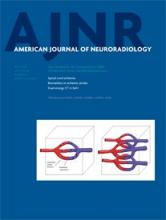Research ArticleNeurointervention
Uncertainty and Agreement Regarding the Role of Flow Diversion in the Management of Difficult Aneurysms
T.E. Darsaut, J.-C. Gentric, C.M. McDougall, G. Gevry, D. Roy, A. Weill and J. Raymond
American Journal of Neuroradiology May 2015, 36 (5) 930-936; DOI: https://doi.org/10.3174/ajnr.A4201
T.E. Darsaut
aFrom the Division of Neurosurgery (T.E.D., C.M.M.), Department of Surgery, University of Alberta Hospital, Mackenzie Health Sciences Centre, Edmonton, Alberta, Canada
J.-C. Gentric
bDepartment of Radiology (J.-C.G., D.R., A.W., J.R.), Centre Hospitalier de l'Université de Montréal, Notre-Dame Hospital, Montreal, Quebec, Canada
C.M. McDougall
aFrom the Division of Neurosurgery (T.E.D., C.M.M.), Department of Surgery, University of Alberta Hospital, Mackenzie Health Sciences Centre, Edmonton, Alberta, Canada
G. Gevry
cLaboratory of Interventional Neuroradiology (G.G., J.R.), Centre Hospitalier de l'Université de Montréal, Notre-Dame Hospital Research Centre, Montreal, Quebec, Canada.
D. Roy
bDepartment of Radiology (J.-C.G., D.R., A.W., J.R.), Centre Hospitalier de l'Université de Montréal, Notre-Dame Hospital, Montreal, Quebec, Canada
A. Weill
bDepartment of Radiology (J.-C.G., D.R., A.W., J.R.), Centre Hospitalier de l'Université de Montréal, Notre-Dame Hospital, Montreal, Quebec, Canada
J. Raymond
bDepartment of Radiology (J.-C.G., D.R., A.W., J.R.), Centre Hospitalier de l'Université de Montréal, Notre-Dame Hospital, Montreal, Quebec, Canada
cLaboratory of Interventional Neuroradiology (G.G., J.R.), Centre Hospitalier de l'Université de Montréal, Notre-Dame Hospital Research Centre, Montreal, Quebec, Canada.

REFERENCES
- 1.↵
- Becske T,
- Kallmes DF,
- Saatci I, et al
- 2.↵
- Lylyk P,
- Miranda C,
- Ceratto R, et al
- 3.↵
- Nelson PK,
- Lylyk P,
- Szikora I, et al
- 4.↵
- Barkun JS,
- Aronson JK,
- Feldman LS, et al
- 5.↵
- Darsaut TE,
- Rayner-Hartley E,
- Makoyeva A, et al
- 6.↵
- Kulcsár Z,
- Houdart E,
- Bonafé A, et al
- 7.↵
- Hu YC,
- Deshmukh VR,
- Albuquerque FC, et al
- 8.↵
- Chalouhi N,
- Starke RM,
- Yang S, et al
- 9.↵
- Crobeddu E,
- Lanzino G,
- Kallmes DF, et al
- 10.↵
- 11.↵
- 12.↵
- Arrese I,
- Sarabia R,
- Pintado R, et al
- 13.↵
- van Rooij WJ,
- Sluzewski M,
- van der Laak C
- 14.↵
- McCulloch P,
- Altman DG,
- Campbell WB, et al
- 15.↵
- Chalmers TC
- 16.↵
- 17.↵
- Raymond J,
- Darsaut TE,
- Guilbert F, et al
- 18.↵
- Landis JR,
- Koch GG
- 19.↵
- 20.↵
- Raymond J,
- Darsaut TE
- 21.↵
- Sadasivan C,
- Cesar L,
- Seong J, et al
- 22.↵
- 23.↵
- Darsaut TE,
- Bing F,
- Salazkin I, et al
- 24.↵
- Kulcsár Z,
- Ernemann U,
- Wetzel SG, et al
- 25.↵
- Siddiqui AH,
- Abla AA,
- Kan P, et al
- 26.↵
- Freedman B
- 27.↵
- Drummond MF
- Buxton MJ
- 28.↵
- Cloft HJ
In this issue
American Journal of Neuroradiology
Vol. 36, Issue 5
1 May 2015
Advertisement
T.E. Darsaut, J.-C. Gentric, C.M. McDougall, G. Gevry, D. Roy, A. Weill, J. Raymond
Uncertainty and Agreement Regarding the Role of Flow Diversion in the Management of Difficult Aneurysms
American Journal of Neuroradiology May 2015, 36 (5) 930-936; DOI: 10.3174/ajnr.A4201
0 Responses
Jump to section
Related Articles
Cited By...
- Flow Diversion in the Treatment of Intracranial Aneurysms: A Pragmatic Randomized Care Trial
- Factors Influencing Confidence in Diagnostic Ratings and Retreatment Recommendations in Coiled Aneurysms
- Flow diversion of bifurcation aneurysms is more effective when the jailed branch is occluded: an experimental study in a novel canine model
This article has not yet been cited by articles in journals that are participating in Crossref Cited-by Linking.
More in this TOC Section
Similar Articles
Advertisement











